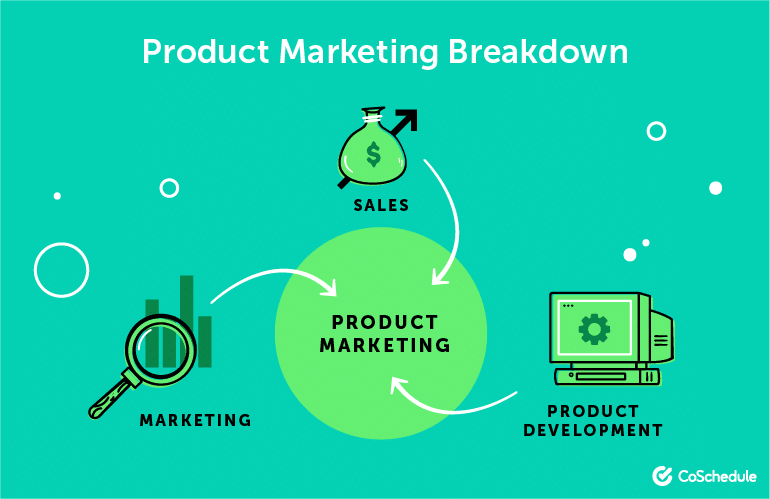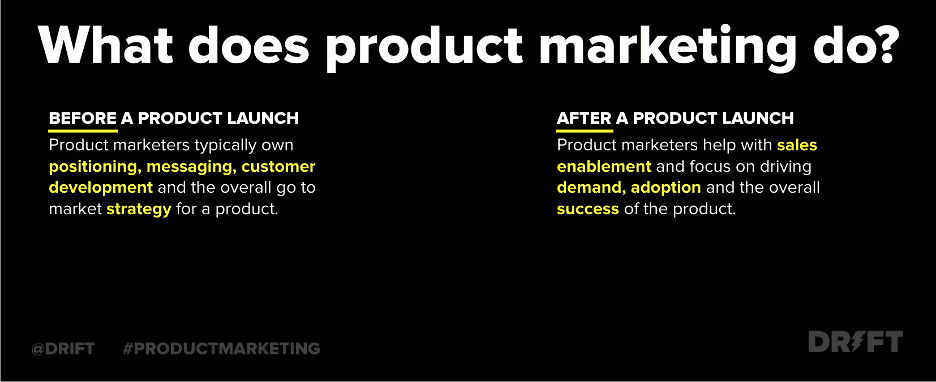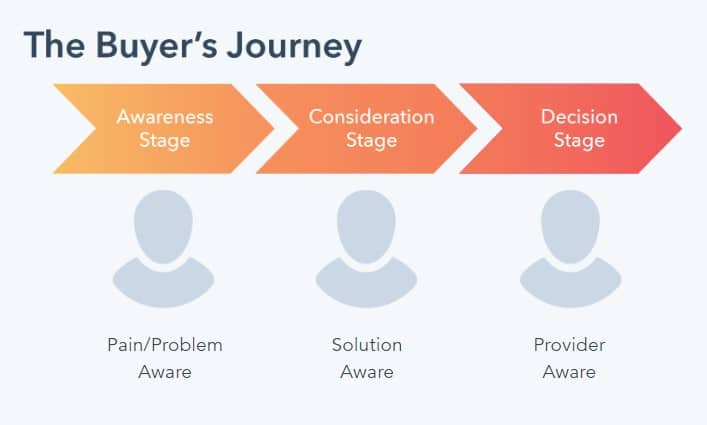
11 Product Marketing Strategies to Grow Your Customer Base
When you hear the phrase “product marketing,” what are some of the first brands that come to mind?
You might think of Coca-Cola, Apple or Nike – each one a giant in its respective industry.
Product marketing is all about the consumer. To be a successful product marketer, you must pull the consumer into your narrative. They must see themselves as the protagonist in your story and feel like you’re speaking directly to them through marketing and advertising.
The stronger the connection you can form with consumers, the stronger your products will perform on the market.
All the brands mentioned above understand the importance of customer-centricity. Each one is an expert at connecting with, drawing in, and deeply engaging consumers by placing them at the center of the narrative.
It used to be that companies could stay comfortably within the confines of product design and marketing. Today, however, what used to work doesn’t anymore, and your brand has to be more than just a logo and a product. Every company stands for something, and now, exhibiting those values is key to connecting with and satisfying your consumers.
Quick Takeaways
- Product marketing is where sales, marketing, and product development overlap.
- Product marketers must have a solid understanding of their target audience to launch and sell products successfully.
- Successful product marketing will help your business stand out against competitors, connect deeply with consumers, boost revenue, and build a loyal customer base.
What is Product Marketing?
Product marketing involves bringing products to market and then promoting and selling them to consumers. It’s where marketing, sales, and product development come together.
Product marketers will market new products, empower the sales team to sell better, and work with the product development team to ensure their products meet consumer needs.

Source: CoSchedule
More specifically, product marketers have three main jobs:
- Determining product positioning and messaging to sell effectively
- Launching a new product and ensuring consumers understand its value
- Driving demand and sales for the product
Product marketers must have a good understanding of their target audience and market. They must strategically position their products and use messaging that grabs users’ attention and captures their interest. Then they can drive demand for the product to boost company revenue.

Source: Drift
Different product marketers are responsible for different pieces of this process. One may be solely responsible for coming up with the messaging that connects with target consumers. Another may have the role of driving demand for the product or working with the sales team to ensure they have the information and resources to sell the products effectively.
Product marketers work primarily at the bottom of the sales funnel (BOFU) to encourage prospects to buy. Most product marketing activities also take place in the evaluation/decision stage of the buyer’s journey. In other words, product marketers are responsible for getting people to purchase products and become loyal customers.

Source: HubSpot
Why is Product Marketing Important?
If you sell products, you need product marketing. Without it, your sales and other marketing efforts will fall short.
Product marketing enables you to gain deep insights into the wants and needs of your target audience. It helps you understand them better so you can target them more effectively. You’ll also learn more about your competition and know how to position your product in the market effectively.
Product marketing also empowers your sales, marketing, product, and customer service teams to get on the same page and work toward common goals. In turn, your company can make more sales and boost revenue.
What is a Product Marketing Strategy?
A product marketing strategy is like a roadmap that gives you the directions you need to position, price, and promote your products successfully. It will show you how to get from the initial product development stage to launching, marketing, selling, and building customer loyalty.
Here are the essential stages of product marketing:
- Identify your target market, and develop your buyer personas.
- Determine your product’s positioning in the market through strong messaging. Understand who the product is for, what it does, why customers will want it, and how it’s unique.
- Share positioning and messaging with everyone in the company.
- Set goals for your new product.
- Price the product.
- Develop an effective launch plan.
- Create content for the launch.
- Prep the team for launch.
- Launch the product.
- Measure your success by monitoring feedback – both internal and external.
- Track metrics.
11 Effective Product Marketing Strategies
Incorporating these powerful product marketing strategies can help you stand out from the competition, connect with consumers on a deeper level, and build a loyal customer base.
1. Define and Espouse Your Company’s Values
Cause marketing has ballooned in popularity during the last few years. And this approach will not only help you retain customers, but it will aid your company in cultivating brand evangelists. When given a choice between two brands of equal quality and price, most consumers will almost always choose the one with a socially or environmentally conscious cause. In some cases, they’re even willing to pay more to help support it.
In fact, more than 90 percent of consumers in the U.S. prefer brands that actively engage in social or environmental causes. For instance, by partnering with a charity to tackle a social or environmental problem, brands can promote their causes while boosting their image in the eyes of like-minded consumers.
This shift in consumer focus from price to purpose has been problematic for some companies, but others have taken on the challenge to deliver more to their customers. For brands to succeed at this, consistent values need to be at the foundation of what the company offers consumers, according to Kelly Vlahakis-Hanks, CEO of Earth Friendly Products, which makes ECOS environmentally friendly cleaners.
In a Forbes article, she described her company’s approach: “By creating our products based on [our] values, we’ve reached new heights of sustainability and now share our ECOS cleaners with millions of consumers who care about their health and the health of our planet.” Yet mixing philanthropy with business strategy is tricky; consumers can spot publicity stunts from a mile away, and insincerity can do significant damage to a brand’s image.
Therefore, how you tell the story of your brand’s cause and who you tell it to will determine your campaign’s perceived authenticity and, ultimately, your success. Your company’s values should be more than just a few flowery sounding words. Communication, respect, and integrity sound noble, but they’re also three of the values Enron claimed as a company. By themselves, words mean nothing. Instead, consider the actual values that have guided your company’s biggest moments in the past, and then highlight them so they can continue guiding your company’s future.
Your values are the things that influence how your company handles challenges and what you prioritize when making decisions. Under a tight deadline, do you still concentrate on quality over speed? Have you invested in ways to make your company and its products more eco-friendly, even if your bottom line takes a hit? Use the knowledge you gain from this self-examination to build on your values through cause marketing and tell the story of your efforts to others who share those values.
2. Target the Right Audience
The more defined your company’s values are, the easier it becomes to find consumers who will relate most to your brand. As with all forms of marketing these days, consumer data will be your strongest tool for doing so. You can segment your audience members into value preferences by analyzing their digital footprints to track previous purchase preferences, social media activity, and more. These metrics can reveal a theme regarding what each consumer finds important.
Asha Saxena, CEO and chairperson of data management firm Future Technologies, Inc., recommends crafting a “data-innovation map” that will provide “a bird’s-eye view of your customers’ experience and show you how you can be more innovative with data — not to mention save time and drive revenue.” Plotting the customer journey and collecting data at each interaction point will enable you to understand your customers’ values and preferences in actionable ways.
Once you’ve created a cohort of ideal consumers based on shared values, you can market your brand and its cause more effectively. Depending on the level of segmentation you’ve implemented, you can even adjust the emphasis on your cause for each message according to level of interest.
3. Think Outside the Box
Product marketers should dare to be creative and think outside the box if they want to stand out and make waves in their market. Taking calculated risks is a crucial strategy for growth.
Don’t skip any of the stages required for a successful product launch. Instead, get creative in how you position and market your products. The world is changing fast. You can remain a follower in your field or start spearheading new ideas and become a trailblazer.
Consider these questions to brainstorm ways to stand out, be bold, and take smart risks.
- What makes the product unique?
- What makes the product better than similar products out there?
- Why should consumers trust your business?
- Why should people invest money into your product?
- What features perfectly fit your ideal audience?
- What makes your company different?
- What does your product offer consumers that competitor products can’t?
4. Pair with Content Marketing
While product marketing is more sales-focused, content marketing focuses more on building your brand. Product marketing involves positioning and messaging to launch and sell products successfully. Content marketing focuses on creating quality content to attract a target audience. So how can they work together?
To make the best buying decisions possible, customers need both marketing types at different stages of their buying journey. Content marketing can be a massive asset to product marketers. You can leverage it to inform and educate potential buyers about your business and products.
Content marketing also creates context, explaining to consumers how the product’s features and specifications can provide value and help them solve a problem or remove pain points. It can also help explain how a product works and what benefits it offers.
In a nutshell, content marketing is more educational than promotional. It can help you nurture leads at the top of the sales funnel. It can help naturally lead people from the awareness stage to the consideration stage and finally to the decision stage – where product marketing jumps in and takes over.
5. Choose the Right Pricing Structure
There are two ways to price products – based on competition or value. Competitive pricing is based on the pricing of similar products your competition sells. If it’s leaps and bounds better than the competition, you can price it higher. If it’s a more basic version with fewer benefits and features, you should lower the price.
Value-based pricing is for businesses that sell products with little to no competition. Price your products based on how much value they will bring your customers. You generally have more flexibility using this pricing model.
6. Create a New Brand if Necessary
If your audience already has a clear perception of your brand and product line, consider launching a new brand name for a product that falls outside your usual niche.
Procter & Gamble started as a soap and candle company over 180 years ago. Today, they’re the world’s largest consumer goods company – with over 65 brands and 5 billion customers worldwide. Leading brands include Tide, Swiffer, Pampers, Charmin, Crest, Old Spice, and NyQuil.
They don’t only have one brand per product line, though. They’ve invented several unique brands in a variety of product categories. In haircare, they own Pantene, Herbal Essences, Head & Shoulders, Aussie, and VS Sassoon – each a unique brand with its own consumer base.
7. Tell Powerful Stories
Storytelling is a powerful way to sell without being “salesy.” Brand storytelling allows you to bring the consumer into the narrative and make them the center of the story. Through compelling stories, you can connect with people personally and emotionally to make your brand more memorable.
You can also take your potential customers behind the scenes to give them insights into your business’s mission and values through brand storytelling. If you develop your products ethically and thoughtfully, show your audience. The backstory will stick with them and help you build trust.
No matter how sincere your efforts are, the quality of your storytelling will determine how genuine consumers perceive your message to be. Consumers require authenticity. As that demand increases, the art of storytelling becomes an increasingly vital skill for brands and marketers to learn.
Consumer data and social media have dramatically changed how consumers interact with brands, and the emotional connection of storytelling is what appeals to them most. However, online interactions have also changed how consumers pay attention. You can’t tell all of your story at once. Instead, dole out chunks of it through different media at the right time to create a comprehensive, fulfilling story that consumers are excited to follow.
Every brand post your audience members sees on their Facebook and Twitter feeds or the short ad before their next YouTube video will build on the story you’ve been telling them all along. Your audience will remain engaged, and your message will build stronger, more lasting trust in your brand.
In the end, remember that product marketing is never about you, your business, or even your product. It’s about your consumer. It’s about empathy. Telling authentic human stories and creating bonds through shared ideas make storytelling an effective marketing tactic.
8. Leverage Your Current Customer Base
Don’t forget about your repeat business potential. Your current customers already know your business and the quality of your products. It will take less work to convince them to buy from you again than to nurture a cold lead into a sale.
Make sure your business’s customer support team is excellent so you can leverage your current customer base. Consider offering special discounts or promotions to long-term or past customers. You can also develop a loyalty program that keeps them up to date with your business and interested in your products.
9. Study Your Competitors
Who’s out there doing what you want to be doing? Who gets better results and resonates more with your target audience?
Studying your top competitors is a smart strategy. Learn from their successes and failures online, in advertising, and on social media. You’ll gain a deeper understanding of your market.
As you’re studying your competitors, ask these questions:
- Why are consumers buying from them?
- What makes them unique?
- What benefits do they offer that your company doesn’t?
- How do they interact with people on social media?
- What language do they use in their marketing?
- How do they address their target audience?
- How often do they publish content, and which channels do they use?
- Which posts are performing best?
- Are they doing anything special to stand out?
Studying the competition will help you:
- Know who you’re up against.
- Know if you’re falling behind anywhere.
- Better understand and narrow down your target market.
- Identify new opportunities for promotion and distribution.
- Avoid common pitfalls.
10. Update Your Product Over Time
To remain relevant, you’ll need to update the products you sell and how you market them. If your current customers “grow out of” what you offer, you’ll have to figure out how to market to a younger generation. It will likely be different from how you reached and connected with consumers previously.
Conversely, it may be your product that becomes outdated for your current audience. In this case, you’ll need to modify the product and change your marketing tactics to stay relevant over time.
11. Listen to Your Customers
New ideas and innovation are often shot down because decision makers think it’s wise to just give consumers what they want. They’re partially right — a brand only succeeds if it fulfills its customers’ expectations. That said, what they actually mean is that they want to keep doing what’s worked in the past rather than rock the boat.
However, consumers change, and as they do, their wants, needs, and expectations change. The companies that grow are those that can anticipate what consumers will want by learning who they are, what they value, and what they want their favorite brands to value as well.
The best way to create a customer-centric product and market it effectively is by listening to your current customers’ needs. Here are several ways to listen intently.
- Use Facebook or LinkedIn to create a user group. You can ask questions and interact with your customers one-on-one.
- Send out a survey. Ask specific questions for targeted feedback. Customers will appreciate your efforts to make products and experiences better for them. They’ll feel valued that you’re asking for their opinions. You’ll also learn about the pros and cons of what you offer, along with the language your audience uses.
- Read online reviews. You can compare your reviews with your competitors’ to see where you’re performing well or missing the mark.
- Talk to your customer support team. They’ll have a better understanding of the challenges your customers face.
Examples of Product Marketing in Action
Here are three real-life examples of brands that market their products like champs.
Dove
For years, Dove has been redefining beauty by challenging the status quo. In this campaign, they took it a step further by shattering beauty stereotypes and showing real images of women from all walks of life.
Spotify
Spotify has changed the way the world listens to music. Rated “the best music service overall” in 2021 by Business Insider, Spotify is easily accessible, has millions of songs and podcasts, and can be used on any major platform. It allows consumers to create and share playlists, has a radio feature like Pandora, and creates custom playlists based on listeners’ interests.

Mailchimp
Mailchimp is another product marketing wiz. They make it easy to quickly set up and send out email campaigns for marketers of all skill levels. Today, it’s more than an email marketing platform. It’s become an “all-in-one tool” for helping businesses grow.

Strengthen Your Product Marketing Strategies with Content Marketing
By creating and publishing high-quality content consistently on your website, you’ll build authority online to attract a larger audience. You can engage and nurture consumers to move through the buyer’s journey and warm them up for your sales pitch. Content marketing will help set your product marketing team up for success.
MIG offers an affordable package of targeted weekly content to help you reach, engage, and win new customers. With our Content Builder Service, we’ll create a customized strategy for your unique business and audience to help you one-up your competition.






